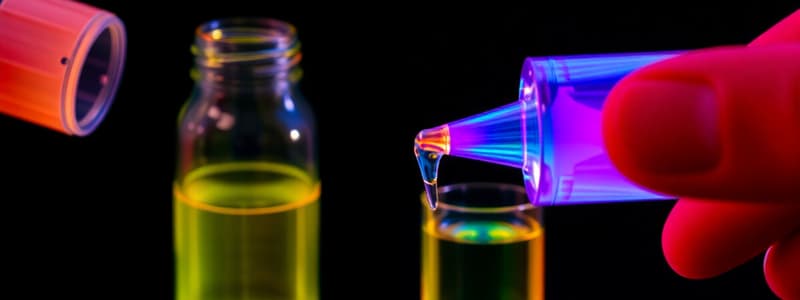Podcast
Questions and Answers
What is the primary purpose of fluorescence spectroscopy in the context of chemical analysis?
What is the primary purpose of fluorescence spectroscopy in the context of chemical analysis?
- To analyze the thermal properties of solutions
- To determine the molecular weight of a substance
- To estimate the concentration of fluorescent chemicals (correct)
- To measure the total absorbance of a solution
In the calibration curve provided, what is the value of R², indicating the strength of the correlation between glucose concentration and absorbance?
In the calibration curve provided, what is the value of R², indicating the strength of the correlation between glucose concentration and absorbance?
- 0.9
- 0.5
- 0.75
- 0.975 (correct)
Calculate the glucose concentration when the absorbance is 0.9 using the provided equation.
Calculate the glucose concentration when the absorbance is 0.9 using the provided equation.
- 8.25 mg/L
- 7.66 mg/L (correct)
- 9.10 mg/L
- 6.50 mg/L
Which of the following is NOT a technique mentioned for elemental analysis?
Which of the following is NOT a technique mentioned for elemental analysis?
What key difference is highlighted between fluorescence and phosphorescence?
What key difference is highlighted between fluorescence and phosphorescence?
What is the primary role of an indicator in chemical analysis?
What is the primary role of an indicator in chemical analysis?
How does UV spectroscopy determine the concentration of a colored chemical?
How does UV spectroscopy determine the concentration of a colored chemical?
In a typical calibration curve, what is plotted on the x-axis?
In a typical calibration curve, what is plotted on the x-axis?
What does the term 'monochromator' refer to in UV spectroscopy?
What does the term 'monochromator' refer to in UV spectroscopy?
How is an unknown concentration of a chemical estimated in a solution?
How is an unknown concentration of a chemical estimated in a solution?
What property of light is mainly measured in UV spectroscopy?
What property of light is mainly measured in UV spectroscopy?
When using a calibration curve, how do you calculate concentration from absorbance?
When using a calibration curve, how do you calculate concentration from absorbance?
What is the purpose of preparing samples with known concentrations before testing unknown samples?
What is the purpose of preparing samples with known concentrations before testing unknown samples?
Flashcards
Calibration Curve
Calibration Curve
A graph that shows the relationship between the absorbance of a solution and the concentration of the analyte. It is used to determine the concentration of an unknown sample by measuring its absorbance and finding the corresponding concentration on the curve.
Fluorescence Spectroscopy
Fluorescence Spectroscopy
A technique that measures the fluorescence (emission) of a solution when it is excited at a specific wavelength. The intensity of the fluorescence is dependent on the concentration of the fluorescent chemical.
Emission Wavelength
Emission Wavelength
The wavelength at which the maximum fluorescence emission is observed for a fluorescent compound. It is unique to each fluorescent molecule.
Excitation Wavelength
Excitation Wavelength
Signup and view all the flashcards
Fluorescence
Fluorescence
Signup and view all the flashcards
Indicators
Indicators
Signup and view all the flashcards
UV (Ultraviolet) Spectroscopy
UV (Ultraviolet) Spectroscopy
Signup and view all the flashcards
Monochromator
Monochromator
Signup and view all the flashcards
UV-Vis Spectrophotometry
UV-Vis Spectrophotometry
Signup and view all the flashcards
Absorbance (A)
Absorbance (A)
Signup and view all the flashcards
Unknown Sample
Unknown Sample
Signup and view all the flashcards
Blood Test for Glucose
Blood Test for Glucose
Signup and view all the flashcards
Study Notes
Instrumental Analysis
- Techniques for measuring chemical composition and properties
- Indicators are chemicals that change colors under specific conditions
- pH-dependent indicators change color based on H+ concentration
- Some indicators react with specific chemicals altering their color
UV (Ultraviolet) Spectroscopy
- Measures absorbance (A) of solutions
- Absorbance is directly proportional to concentration of colored chemicals
- Intensity of colors depends on the concentration of colored chemicals
Monochromator
- Separates wavelengths, directing the desired wavelength to the target
- Uses a prism or diffraction grating
UV-Visible Spectrometer and Working Principle
- Includes a light source, wavelength selector, monochromator, sample, detector, and signal processing unit
- Measures absorbance proportional to concentration of the chemical
Methodology (UV-Vis)
- Prepare solutions with known concentrations of a chemical
- Generate a calibration curve
- Measure absorbance of an unknown solution
- Use the calibration curve to determine the unknown concentration
Example
- Calibration curve showing absorbance values for various known chemical concentrations
- Shows a linear relationship between chemical concentration and absorbance
- Provides an example of calculating the concentration of an unknown sample (0.36 mM)
Blood Test Question
- Indicator for measuring glucose concentration in blood
- Measure absorbances of samples with known glucose concentrations at 500 nm
- Data used for creating calibration curves
Blood Glucose Concentration
- Demonstrates relationship between glucose concentration (mg/L) and absorbance
- Calibration curve shows linear relationship between concentration and absorbance (f(x)= ... formula included)
- Uses the calibration curve or formula to determine unknown concentrations (example of calculation)
Fluorescence Spectroscopy
- Measures fluorescence (emission) of samples after excitation at a specific wavelength
- Emission depends on excitation wavelength and concentration
- Estimates concentration of fluorescent chemicals
- Antioxidant capacity measurements
Fluorescence Spectrometer and Working Principle
- Light source, excitation monochromator, sample holder, emission monochromator, detector, readout device
- Directs and detects emitted light for analysis
Calibration Curve for Fluorescence Spectrometer
- Prepare samples with known concentrations
- Measurements taken at specific excitation and emission wavelengths
Elemental Analysis
- Techniques used for analyzing chemical composition of elements
- Includes flame photometer, atomic absorption, and ICP methods
Studying That Suits You
Use AI to generate personalized quizzes and flashcards to suit your learning preferences.
Related Documents
Description
Explore the techniques and principles of UV-Visible spectroscopy in this quiz. You'll learn about the measurement of absorbance, the role of monochromators, and how concentration affects color intensity in solutions. Test your knowledge on the methodologies used in instrumental analysis.




